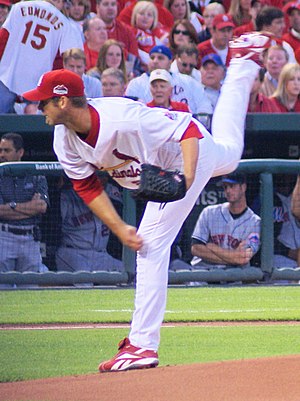 It’s been famously noted that the postseason is a crapshoot. While there is definitely some truth to that statement, for the St. Louis Cardinals the National League Division Series against the Los Angeles Dodgers brought both old and new reasons for a hasty exit from October.
It’s been famously noted that the postseason is a crapshoot. While there is definitely some truth to that statement, for the St. Louis Cardinals the National League Division Series against the Los Angeles Dodgers brought both old and new reasons for a hasty exit from October.
There’s no doubt that the unexpected occurred in this series. After the Cardinals struck first for a run in the top of the first in Game 1, they handed the ball to Chris Carpenter. Some nights, one run for Carp would hold up for nine innings. In this game, it didn’t survive two batters.
If that had been the extent of it, the Cardinals were still in the ballgame. However, Carpenter didn’t have the stuff that put him in the discussion for the Cy Young Award. If your ace is allowing five runs, it makes it much harder to win. The Dodgers tried to help, as the Cardinal offense continued to put runners on, but it was a situation of “bending but not breaking.”
The lack of situational hitting was a weakness all season long for the Cardinals, save for occasional breakout games here and there. So the fact that they were only able to get one run out of a bases-loaded, no-out situation (and that only because Ryan Ludwick flared one just past an outstretched Ronnie Belliard) was not surprising, nor the fact that the three runs they scored in Game 1 was their high water mark for the series.
The Cardinals one real chance to extend October past the minimum came in Game 2. Again, the Cardinal offense was unable to do much, fashioning just two runs off of Clayton Kershaw and the other Dodger hurlers. That was almost enough, though. It should have been enough. Adam Wainwright pitched an impressive eight innings and left with a two run lead.
It wasn’t a complete surprise, however, that Ryan Franklin blew that lead. Franklin had struggled down the stretch, a period of time that almost exactly corresponded to when he signed an extension with the team. Franklin got the first two outs and, in fairness, should have gotten out number three. However, the unexpected reared its head once again.

- Image by Getty Images via Daylife
A fly ball to Matt Holliday, a routine fly that should have ended the game with the Cardinals on top, was lost in the white towels and lights of Dodger Stadium. Holliday had no idea where the ball was until it hit him in his midsection. Costly, to be sure, but if Franklin would have gotten any of the next four batters, the Cardinals would have at least had another at-bat. As it was, the gates were opened and the Dodgers stole Game 2.
Normally, you’d have seen the Cardinals come back to Busch Stadium and at least make a stand in Game 3, since their playoff lives were on the line. Sadly, though, for whatever reason, they never made a serious charge in that game, getting down 1-0 before they even came to the plate. That 1-0 lead consistently grew until it reached its 5-0 final and, with it, the end of the season for St. Louis.
Usually, the beginning of the offseason is fairly quiet for St. Louis. Tony LaRussa takes time to determine whether he’ll be back, they look at signing the backup catcher, fairly routine things. This year, there was a little more of a spark to get the hot stove going.
LaRussa spent some time pondering his return, as he was a technical as well as practical free agent from the club. While it wasn’t surprising that the introspection and checking with players led to his return—there was little chance a competitor like LaRussa would go out on that sour note of an NLDS—who he brought back with him was.
Hal McRae had been the hitting coach for the Cardinals the past five seasons. It was becoming obvious, though, that a change was needed in that slot. The offense underperformed, was rarely able to get a key hit, and just couldn’t seem to click even with the additions of Matt Holliday and Mark DeRosa. So the fact that McRae was let go didn’t surprise many observers.

- Image by Getty Images via Daylife
However, bringing in former Cardinal slugger Mark McGwire to take his slot did send people buzzing and eyebrows raising. McGwire, whose past history has been fully discussed and is not a mystery to any casual baseball fan, had been living a hermit-like existence in California since his retirement in 2001 and most especially since his Congressional testimony in 2005. While LaRussa had wanted Big Mac to return to spring training as an instructor the past few years, he had always been rebuffed. However, McGwire was amendable to this level of responsibility.
McGwire has not yet made any comments to the press, though the Cardinals expect that he will talk to the media in the next week or so. There are two paths the red-headed slugger can take—continued stonewalling or a frank discussion, including an honest answer to whatever he may have done. Time will tell which path is chosen, but either way will make a significant impact on the 2010 season.


![Reblog this post [with Zemanta]](http://img.zemanta.com/reblog_e.png?x-id=b66ccb9d-b671-48d2-920b-4e0037b1e72a)
